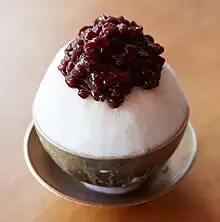 Pat-bingsu (red bean bingsu) | |
| Alternative names | Bingsoo |
|---|---|
| Type | Shaved ice |
| Course | Dessert |
| Place of origin | Korea |
| Serving temperature | Cold |
| Main ingredients | Ice, toppings |
| Variations | Pat-bingsu (red bean bingsu), nokcha-bingsu (green tea bingsu), ttalgi-bingsu (strawberry bingsu), choko-bingsu (chocolate bingsu), etc |
| Korean shaved ice | |
| Hangul | 빙수 |
|---|---|
| Hanja | 氷水 |
| Revised Romanization | bingsu |
| McCune–Reischauer | pingsu |
| IPA | [piŋ.su] |
| Red bean shaved ice | |
| Hangul | 팥빙수 |
| Hanja | 팥氷水 |
| Revised Romanization | pat-bingsu |
| McCune–Reischauer | p'at-pingsu |
| IPA | [pʰat̚.p͈iŋ.su] |
Bingsu (Korean: 빙수; Hanja: 氷水), sometimes written as bingsoo,[1] is a milk-based Korean shaved ice dessert with sweet toppings that may include chopped fruit, condensed milk, fruit syrup, and red beans.[2][3]
The most common variety is pat-bingsu (Korean: 팥빙수), the red bean shaved ice. The main ingredient of ice was natural ice in the past, but later artificial ice was produced and high-quality sweeteners were developed, and now it has been improved into boiled red bean shaved ice or fruit shaved ice mixed with various fruits. At first, the ice-cutting machine was a simple tool in the shape of a plane, but now the electric power is widely used after a manual rotation by hand.
History
The earliest forms of bingsu existed during the Joseon dynasty (1392–1897). The government records show that the officials shared the crushed ices topped with various fruits, which were distributed from the ancient Korean ice storage called seokbinggo (Korean: 석빙고). [4][5] The early forms of patbingsu consisted of shaved ice and two or three ingredients, typically red bean paste, tteok, and ground nut powder.[6]
The modern versions of the iced desserts began to be sold in Taegeukdang (Korean: 태극당), the oldest bakery in Seoul that opened in 1946. With the western influences after the Korean War, more various and richer ingredients, such as cereals, syrups, ice creams, or whipped creams, were added to patbingsu.[7][8]
The use of stored and gathered ice for use in confections has been documented in Ancient Persia since 400 BCE onward.[9]
In the 11th century, Japan and China had similar shaved ice.[10]
Varieties
Patbingsu (팥빙수, 팥氷水, sometimes anglicized as patbingsoo, literally "red beans shaved ice") is a popular Korean shaved ice dessert with sweet toppings that may include chopped fruit, condensed milk, fruit syrup, and red beans.[2]
The food began as ice shavings with red beans (known as pat, 팥). Many varieties of patbingsu exist in contemporary culture.
There are a variety of bingsu types and flavors. Many bingsu do not necessarily follow tradition, and some do not include the red bean paste.[11] Some popular flavors are: green tea, coffee, and yogurt.[12]
In various countries
Korea
In addition to the existing patbingsu, several Korean franchises have made shaved ice made from various ingredients such as Injeolmi shaved ice, melon shaved ice, coffee shaved ice, and green tea shaved ice. Since the Joseon Dynasty, it was the first time to mix honey and fruit with ice taken from seokbinggo, and after the Korean War, condensed milk, syrup, and chocolate were introduced from the United States and modern "Korean shaved ice" began to be made. Now, bingsu can be found at almost every dessert shop in Korea.[13]
Japan
In a tea shop in Kagoshima, Shirokuma (the white bear, 白熊) was made, and the shape of white condensed milk poured over shaved ice in a round bowl and fruits such as sweet red beans, cherries, and tangerines was named after what looked like a white bear's face.
Singapore
Due to the characteristics of mangoes, mango shaved ice with many mangoes is also famous, as served in a store in Singapore. The "Monster bingsu" is also famous for freezing various flavors of milk, grinding it into layers, and putting chocolate shaped like eyeballs. This variant has shaved ice grounded to show the grain of milk rather than ice with water.[14]
Gallery
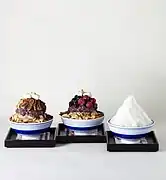 Various bingsu
Various bingsu Patbingsu
Patbingsu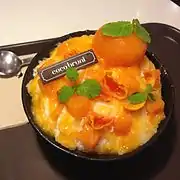 Persimmon bingsu
Persimmon bingsu Bingsu with ice cream
Bingsu with ice cream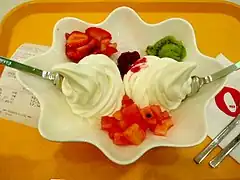 A yogurt bingsu
A yogurt bingsu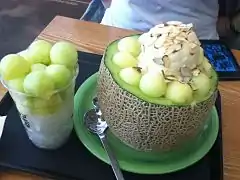 Melon bingsu
Melon bingsu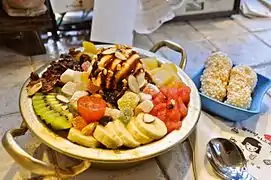 Patbingsu topped with fruits
Patbingsu topped with fruits Berry bingsu
Berry bingsu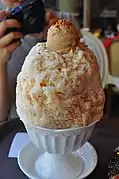 Milk tea bingsu
Milk tea bingsu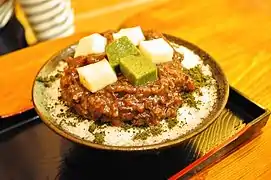 Black sesame bingsu
Black sesame bingsu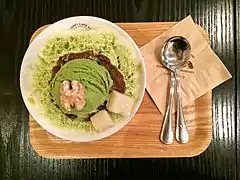 Green tea bingsu
Green tea bingsu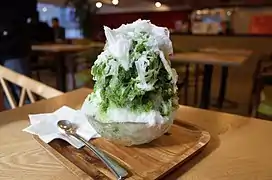 Green tea bingsu
Green tea bingsu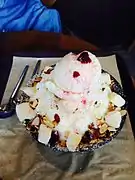 Cheese bingsu
Cheese bingsu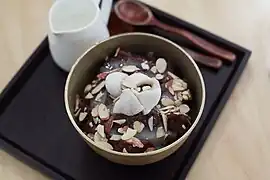 Patbingsu
Patbingsu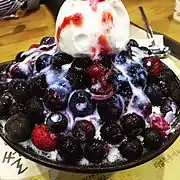 Mixed-berry bingsu
Mixed-berry bingsu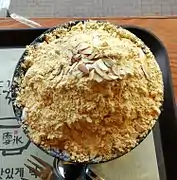
See also
Shaved ice § Regions, for similar shaved ice variations around the world.
- Kakigōri: Japanese shaved ice
- Tshuah-ping: Taiwanese shaved ice
- Halo-halo: Filipino shaved ice
- Es campur and Es teler: Indonesian shaved ice
- Namkhaeng sai and O-aew: Thai shaved ice
- Ais Kacang (ABC, Ice Kacang): Malaysian/Singaporean shaved ice
- Grattachecca: Italian shaved ice popular in Rome.
- Hawaiian shave ice: Hawaiian shaved ice
References
- ↑ Hoo, Winyan Soo (July 16, 2014). "Plate Lab: A guide to Asian shaved ice desserts halo-halo, bao-bing and bingsoo". The Washington Post. ISSN 0190-8286. Archived from the original on June 5, 2016. Retrieved May 5, 2016.
- 1 2 Lee, Robyn (June 5, 2009). "Snapshots from South Korea: Patbingsu, a Popular Shaved Ice Dessert". Serious Eats. Archived from the original on June 7, 2009. Retrieved January 5, 2013.
- ↑ Kyoung Woo Jun, for (June 27, 2013). "Seoul hotels at war over dessert - CNN.com". CNN. Archived from the original on July 3, 2013. Retrieved May 5, 2016.
- ↑ Dang, Tae Keuk (September 13, 2010). "Snowy delights and variations on bingsu". Herald Corporation. Archived from the original on May 16, 2021. Retrieved January 6, 2014.
- ↑ 팥빙수[氷水] [Patbingsu]. Doopedia (in Korean). Doosan Corporation. Archived from the original on September 23, 2015. Retrieved January 6, 2014.
- ↑ Min, Ines (June 3, 2010). "Ice cream explorations and a peek into the past". The Korea Times. Archived from the original on January 6, 2014. Retrieved January 5, 2014.
- ↑ "Seoul Eats: The Origin of Patbingsu". Seoul Eats. Archived from the original on August 4, 2020. Retrieved August 9, 2020.
- ↑ "Get ready for patbingsu: Red beans over shaved ice". The Jeju Weekly. Archived from the original on January 6, 2014. Retrieved January 2, 2022.
- ↑ Marks, Gil (November 17, 2010). Encyclopedia of Jewish Food. HMH. ISBN 978-0-544-18631-6. Archived from the original on April 3, 2023. Retrieved March 21, 2023.
- ↑ "[음식평론가 윤덕노의 음食經제] 12세기 동양의 여름은 얼음과 빙수 천국". August 7, 2015. Archived from the original on March 21, 2023. Retrieved March 21, 2023.
- ↑ "Bingsu, an unbeatable summer treat!". KOREA TOURISM ORGANIZATION. Archived from the original on January 6, 2014. Retrieved January 6, 2014.
- ↑ Lee, Ji-yoon (July 7, 2008). "Korea's cold summer taste - naengmyeon and patbingsu". Korea.net. The Korean Culture and Information Service. Archived from the original on January 6, 2014. Retrieved January 6, 2013.
{{cite web}}: CS1 maint: bot: original URL status unknown (link) - ↑ Linda (October 12, 2019). "15 of the Best Bingsu in Seoul". Linda Goes East. Archived from the original on July 25, 2021. Retrieved June 11, 2021.
- ↑ Ang, Daniel. "Roji Monster Ice Cream". Retrieved June 11, 2021.